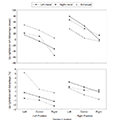Abstract
When up-down stimuli are mapped to left-right responses, an up-right/down-left mapping advantage is found that is modified by response eccentricity and hand posture. These effects can be attributed to correspondence of asymmetric stimulus and response codes formed relative to multiple reference frames. We examined the influence of stimulus-set location on these orthogonal stimulus-response compatibility (SRC) effects. In Experiment 1, the stimulus set appeared in the upper or lower display positions. A spatial code for stimulus-set location was formed, producing Simon-type response eccentricity and hand posture effects, but this code had no influence on the coding of the relevant stimuli. In Experiment 2, the stimulus set appeared in the left, center, or right positions relative to the response location, which also varied, to dissociate the effects of response location, relative to the stimulus display and body midline. The former factor influenced the orthogonal SRC effect for both unimanual switch movements and bimanual keypresses, and the latter factor influenced the effect for only unimanual switch movements. Stimulus-set location causes orthogonal Simon-type effects when varied along the stimulus dimension and provides a referent for response coding when varied along the response dimension.
